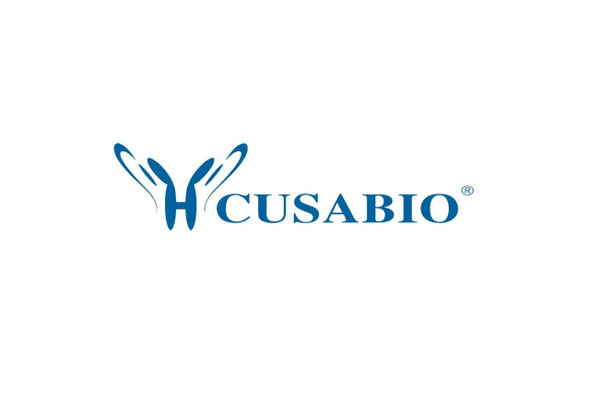Cusabio Human Recombinants
Recombinant Human Protein mono-ADP-ribosyltransferase PARP14 (PARP14), partial | CSB-EP677190HU
- SKU:
- CSB-EP677190HU
- Availability:
- 13 - 23 Working Days
Description
Recombinant Human Protein mono-ADP-ribosyltransferase PARP14 (PARP14), partial | CSB-EP677190HU | Cusabio
Alternative Name(s): ADP-ribosyltransferase diphtheria toxin-like 8 B aggressive lymphoma protein 2 Poly [ADP-ribose] polymerase 14
Gene Names: PARP14
Research Areas: Epigenetics and Nuclear Signaling
Organism: Homo sapiens (Human)
AA Sequence: IPAHWSDMKQQNFCVVELLPSDPEYNTVASKFNQTCSHFRIEKIERIQNPDLWNSYQAKKKTMDAKNGQTMNEKQLFHGTDAGSVPHVNRNGFNRSYAGKNAVAYGKGTYFAVNANYSANDTYSRPDANGRKHVYYVRVLTGIYTHGNHSLIVPPSKNPQNPTDLYDTVTDNVHHPSLFVAFYDYQAYPEYLITFRK
Source: E.coli
Tag Info: N-terminal 10xHis-tagged and C-terminal Myc-tagged
Expression Region: 1605-1801aa
Sequence Info: Partial
MW: 30.0 kDa
Purity: Greater than 85% as determined by SDS-PAGE.
Relevance: ADP-ribosyltransferase that mediates mono-ADP-ribosylation of glutamate residues on target proteins (PubMed:16061477, PubMed:27796300, PubMed:18851833, PubMed:25043379). In contrast to PARP1 and PARP2, it is not able to mediate poly-ADP-ribosylation (PubMed:25043379). Has been shown to catalyze the mono-ADP-ribosylation of STAT1 at 'Glu-657' and 'Glu-705', thus decreasing STAT1 phosphorylation which negatively regulates pro-inflammatory cytokine production in macrophages in response to IFNG stimulation (PubMed:27796300). However, the role of ADP-ribosylation in the prevention of STAT1 phosphorylation has been called into question and it has been suggested that the inhibition of phosphorylation may be the result of sumoylation of STAT1 'Lys-703' (PubMed:29858569). Mono-ADP-ribosylates STAT6; enhancing STAT6-dependent transcription (PubMed:27796300). In macrophages, positively regulates MRC1 expression in response to IL4 stimulation by promoting STAT6 phosphorylation (PubMed:27796300). Mono-ADP-ribosylates PARP9 (PubMed:27796300).
Reference: "Poly(ADP-ribose) polymerase family member 14 (PARP14) is a novel effector of the JNK2-dependent pro-survival signal in multiple myeloma." Barbarulo A., Iansante V., Chaidos A., Naresh K., Rahemtulla A., Franzoso G., Karadimitris A., Haskard D.O., Papa S., Bubici C. Oncogene 32:4231-4242(2013)
Storage: The shelf life is related to many factors, storage state, buffer ingredients, storage temperature and the stability of the protein itself. Generally, the shelf life of liquid form is 6 months at -20?/-80?. The shelf life of lyophilized form is 12 months at -20?/-80?.
Notes: Repeated freezing and thawing is not recommended. Store working aliquots at 4? for up to one week.
Function:
Involvement in disease:
Subcellular Location:
Protein Families:
Tissue Specificity:
Paythway:
Form: Liquid or Lyophilized powder
Buffer: If the delivery form is liquid, the default storage buffer is Tris/PBS-based buffer, 5%-50% glycerol. If the delivery form is lyophilized powder, the buffer before lyophilization is Tris/PBS-based buffer, 6% Trehalose, pH 8.0.
Reconstitution: We recommend that this vial be briefly centrifuged prior to opening to bring the contents to the bottom. Please reconstitute protein in deionized sterile water to a concentration of 0.1-1.0 mg/mL.We recommend to add 5-50% of glycerol (final concentration) and aliquot for long-term storage at -20?/-80?. Our default final concentration of glycerol is 50%. Customers could use it as reference.
Uniprot ID: Q460N5
HGNC Database Link: N/A
UniGene Database Link: N/A
KEGG Database Link: N/A
STRING Database Link: N/A
OMIM Database Link: N/A









